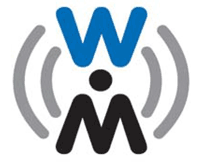Bluetooth is a short-range wireless technology standard that is used for exchanging data between fixed and mobile devices over short distances and building personal area networks (PANs). In the most widely used mode, transmission power is limited to 2.5 milliwatts, giving it a very short range of up to 10 metres (33 ft). It employs UHF radio waves in the ISM bands, from 2.402 GHz to 2.48 GHz. It is mainly used as an alternative to wired connections to exchange files between nearby portable devices and connect cell phones and music players with wireless headphones.

The International Organization for Standardization is an independent, non-governmental, international standard development organization composed of representatives from the national standards organizations of member countries. Membership requirements are given in Article 3 of the ISO Statutes.

The Wi-Fi Alliance is a non-profit organization that owns the Wi-Fi trademark. Manufacturers may use the trademark to brand products certified for Wi-Fi interoperability. It is based in Austin, Texas.

The USB Implementers Forum (USB-IF) is a nonprofit organization created to promote and maintain USB, a set of specifications and transmission procedures for a type of cable connection that has since become used widely for electronic equipment. Its main activities are currently the promotion and marketing of USB, Wireless USB, USB On-The-Go, and the maintenance of standards and specifications for the related devices, as well as a compliance program.

Wireless USB (Universal Serial Bus) is a short-range, high-bandwidth wireless radio communication protocol created by the Wireless USB Promoter Group which intended to increase the availability of general USB-based technologies. It is unrelated to Wi-Fi, and different from the Cypress WirelessUSB offerings. It was maintained by the WiMedia Alliance which ceased operations in 2009. Wireless USB is sometimes abbreviated as WUSB, although the USB Implementers Forum discouraged this practice and instead prefers to call the technology Certified Wireless USB to distinguish it from the competing UWB standard.

The WiMedia Alliance was a non-profit industry trade group that promoted the adoption, regulation, standardization and multi-vendor interoperability of ultra-wideband (UWB) technologies. It existed from about 2002 through 2009.
A Bluetooth stack is software that is an implementation of the Bluetooth protocol stack.
MIPI Alliance is a global business alliance that develops technical specifications for the mobile ecosystem, particularly smart phones but including mobile-influenced industries. MIPI was founded in 2003 by Arm, Intel, Nokia, Samsung, STMicroelectronics and Texas Instruments.
Michael W. Foley is an American electrical engineer, wireless expert and executive director of the Bluetooth Special Interest Group, a consortium of over 12,000 companies who come together to create and promote Bluetooth wireless technology.
TransferJet is a close proximity wireless transfer technology initially proposed by Sony and demonstrated publicly in early 2008. By touching two electronic devices, TransferJet allows high speed exchange of data. The concept of TransferJet consists of a touch-activated interface which can be applied for applications requiring high-speed data transfer between two devices in a peer-to-peer mode without the need for external physical connectors.
SBC, or low-complexity subband codec, is an audio subband codec specified by the Bluetooth Special Interest Group (SIG) for the Advanced Audio Distribution Profile (A2DP). SBC is a digital audio encoder and decoder used to transfer data to Bluetooth audio output devices like headphones or loudspeakers. It can also be used on the Internet. It was designed with Bluetooth bandwidth limitations and processing power in mind to obtain a reasonably good audio quality at medium bit rates with low computational complexity. As of A2DP version 1.3, the Low Complexity Subband Coding remains the default codec and its implementation is mandatory for devices supporting that profile, but vendors are free to add their own codecs to match their needs.
WirelessHART within telecommunications and computing, is a wireless sensor networking technology. It is based on the Highway Addressable Remote Transducer Protocol (HART). Developed as a multi-vendor, interoperable wireless standard, WirelessHART was defined for the requirements of process field device networks.
Bluetooth Low Energy is a wireless personal area network technology designed and marketed by the Bluetooth Special Interest Group aimed at novel applications in the healthcare, fitness, beacons, security, and home entertainment industries. It is independent of classic Bluetooth and has no compatibility, but Bluetooth Basic Rate/Enhanced Data Rate (BR/EDR) and LE can coexist. The original specification was developed by Nokia in 2006 under the name Wibree, which was integrated into Bluetooth 4.0 in December 2009 as Bluetooth Low Energy.
Association for Standardization of Automation and Measuring Systems or ASAM is an incorporated association under German law. Its members are primarily international car manufacturers, suppliers and engineering service providers from the automotive industry. The association coordinates the development of technical standards, which are developed by working groups composed of experts from its member companies. ASAM pursues the vision that the tools of a development process chain can be freely interconnected and allow a seamless exchange of data. The standards define protocols, data models, file formats and application programming interfaces (APIs) for the use in the development and testing of automotive electronic control units. A large amount of popular tools in the areas of simulation, measurement, calibration and test automation are compliant to ASAM standards. Compliance shall guarantee interoperability of tools from different vendors, allow data exchange without the need for converters, and facilitate the exchange of unambiguous specification between customers and suppliers.
The IEEE Industry Standards and Technology Organization (ISTO) is a 501(c)(6) non profitable federation of industry alliances, consortia, and trade groups. Formed in 1999, ISTO has an affiliation with the Institute of Electrical and Electronics Engineers - a separate legal and autonomous entity incorporated in the State of Delaware, USA.
ISA100.11a is a wireless networking technology standard developed by the International Society of Automation (ISA). The official description is "Wireless Systems for Industrial Automation: Process Control and Related Applications".

EM Microelectronic, based in Marin, La Tène near Neuchâtel in Switzerland, is a developer and semiconductor manufacturer specialized in the design and production of ultra low power, low voltage integrated circuits for battery-operated and field-powered applications in consumer, automotive and industrial areas. EM Microelectronic SA is a subsidiary of The Swatch Group.

The OPEN Alliance is a non-profit, special interest group (SIG) of mainly automotive industry and technology providers collaborating to encourage wide scale adoption of Ethernet-based communication as the standard in automotive networking applications.

The Connectivity Standards Alliance (CSA), formerly the Zigbee Alliance, is a group of companies that maintain and publish the Zigbee and Matter standard, along with several others.









